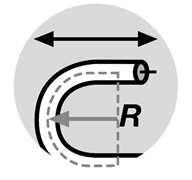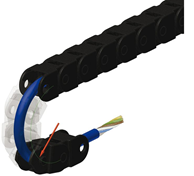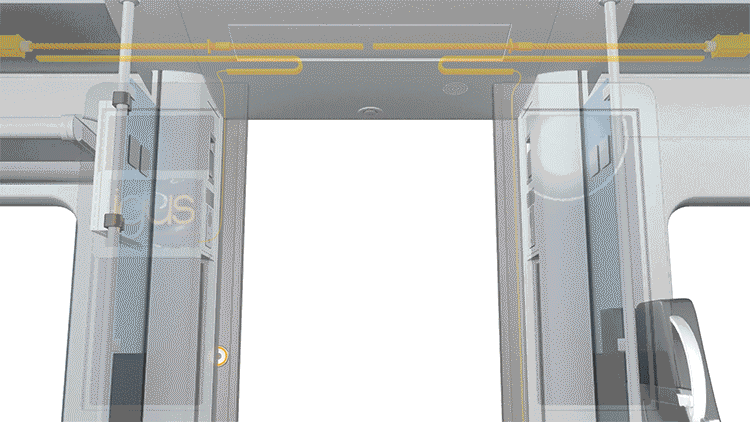What do bend radius and minimum bend radius mean for cables?
igu-blog-adm | 29. October 2021
Time and again we talk about the bend radius in the field of energy chains and cables. We will take a closer look today what this means exactly and why the bend radius is so important.

What is the bend radius?
The bend radius is the radius in which a cable can be bent without getting damaged. Here we consider the exact centre of the cable, i.e. the neutral fibre. The smaller this radius, the more durable the material must be.

The whole thing behaves similar to the human body. The smaller I want to make myself, the more flexible my spine needs to be. If I go beyond my maximum bend, it hurts. Worst case scenario, something breaks, I hurt myself. The same applies to the cables.

Clients often ask us “How much can we bend our cable?” or “How long will our cable last if we bend it like this?”. However, we can only answer this question if we take a closer look at the application and the wider circumstances.
The correct bend radius for a cable
An important factor for the long service life of a cable is the bend radius.
We distinguish between 3 different specifications for the bend radius of our chainflex cables:
- Fixed: The cable is brought into this radius just once for installation and then it no longer moves. This is described in the DIN.
- Flexible: This is the bend radius that the cable occasionally adopts when moving freely. Here, the number of bends is not defined. There are also standardised tests in the norm.
- Chain: This is the radius of the energy chain specified when it is in continuous movement. It is not definitive. That is why we at igus always test on real applications.
The minimum bend radius
Each manufacturer specifies a minimum bend radius . The radius chosen for the chain depends on the cable with the largest diameter. It is important that users always make sure that the correct radius for the chain is considered in the calculations. The manufacturer recommends a minimum radius for a reason. Ideally, use the largest possible radius, falling below which can quickly lead to failure.
However, sharp bending of cables should also be avoided. This means that the cables for moving applications should be supported in such a way that they do not kink due to machine movement.
Does the bend radius change at extreme temperatures?
Yes, temperatures have an effect on the bend radius of a cable and you can say:
The larger the radius, the less the cable is stressed. This increases the service life.
The minimum bend radius is based on a temperature range for bending. Care must be taken if the ambient temperature reaches or exceeds this temperature for the cable.
At cold temperatures the material becomes hard and can break and at too hot temperatures the material becomes soft and high abrasion occurs.
Therefore, a cable with a PUR or TPE jacket for extreme temperatures is recommended for use. Alternatively, you always have the option of contacting us with specific requests.
Cables with a small bend radius
In applications with severe installation space constraints, the radius of the cable tray may need to be smaller than that of standard cables. Although this is not the ideal case, it can be solved by using cables specifically designed for installations with small bend radii.
Other materials are then used here, for example conductors with a special alloy in the stranded wire to prevent wire breakage. With this material a bending factor of 4xd is then possible. With copper, this is not possible with a high number of movements.

Because in dynamic applications with a small bend radius, the copper strands quickly reach their limits. The mechanical load is too high.
Where are cables with a tight bend radius used?
The areas of application for cables with tight bend radii are diverse. One possible application is also in automatic doors for vehicles and trains. They are also used in small handling applications in medical technology or automatic machines.

Conclusion
The subject of bend radius and minimum bend radius is complex. Can we answer any other questions you may have on the subject or help you choose the right cable? We look forward to hearing from you.

